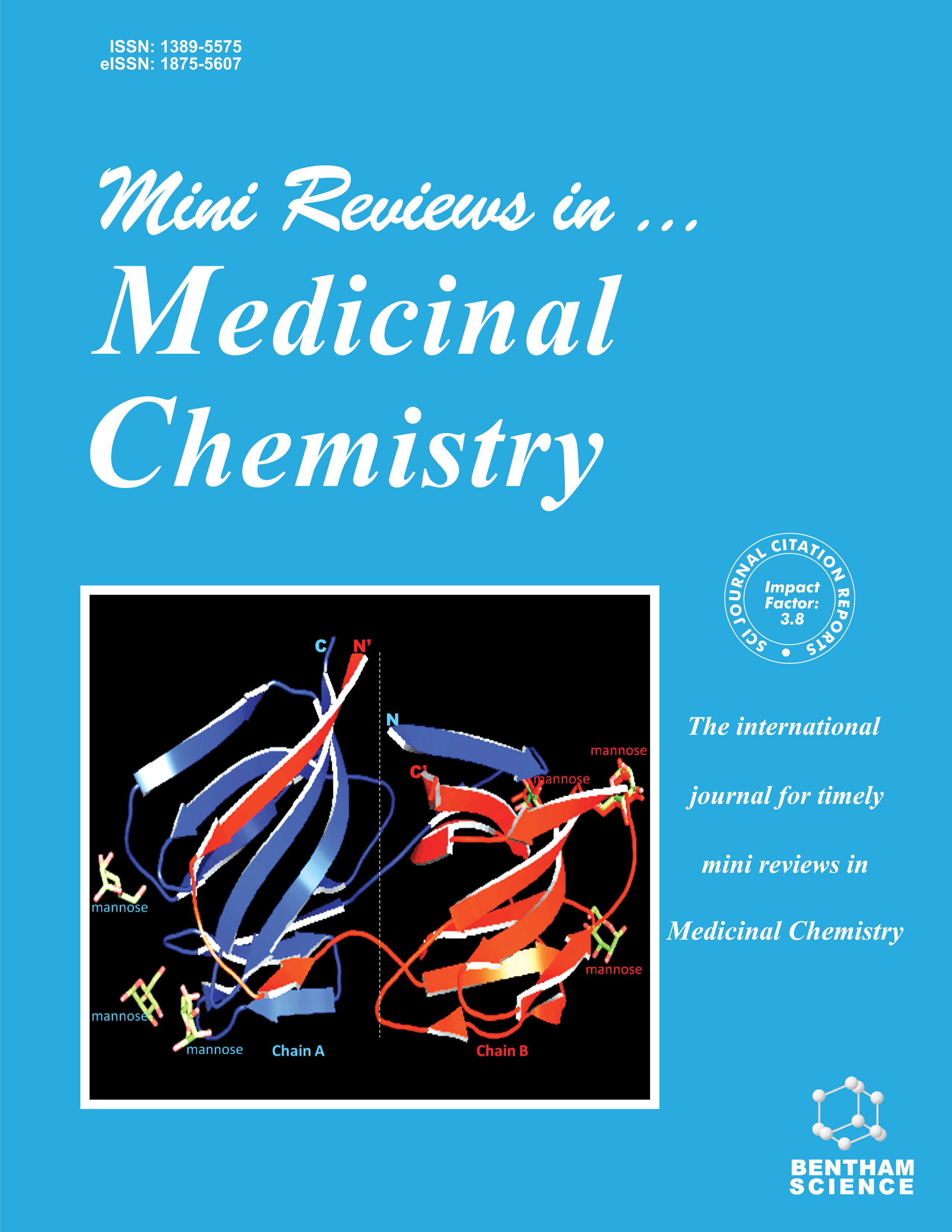- Home
- A-Z Publications
- Mini Reviews in Medicinal Chemistry
- Previous Issues
- Volume 7, Issue 12, 2007
Mini Reviews in Medicinal Chemistry - Volume 7, Issue 12, 2007
Volume 7, Issue 12, 2007
-
-
Combretastatin A-4 Analogs as Anticancer Agents
More LessAuthors: Anurag Chaudhary, S. N. Pandeya, P. Kumar, P. P. Sharma, S. Gupta, N. Soni, K. K. Verma and G. BhardwajCombretastatin A-4 (CA-4) is one of the most potent antimitotic and antiangiogenic agents of natural origin. It has displayed potent antitumor effect in a wide variety of preclinical tumor models. Till date various CA-4 analogs have been synthesized and evaluated for anticancer activity. This review is an attempt to compile the medicinal chemistry of various synthesized CA-4 analogs.
-
-
-
Chemistry and Biology of Heparin Mimetics that Bind to Fibroblast Growth Factors
More LessWe aim from this review to stimulate further research in this area by providing a description of the different types of inhibitors containing heparin mimetic molecules that have recently been reported and data on their biological activity. Molecules that mimic heparin and bind to heparin-binding growth factors are important building blocks for synthetic biomaterials. Different types of synthetic mimics of the biological properties of Read More
-
-
-
Two-Peptide Lantibiotics: A Medical Perspective
More LessAuthors: Elaine M. Lawton, R. P. Ross, Colin Hill and Paul D. CotterLantibiotics are ribosomally synthesised, post-translationally modified antimicrobial peptides that exhibit activity against a wide-range of Gram positive bacteria. During the last decade a number of two-peptide lantibiotics, i.e. lantibiotics that function optimally as a consequence of the synergistic activity of two peptides, have been identified, six of which (lacticin 3147, staphylococcin C55, plantaricin W, Smb, BHT-A and Read More
-
-
-
Tetraspanins-Structural and Signalling Scaffolds that Regulate Platelet Function
More LessAuthors: Matt W. Goschnick and Denise E. JacksonThere are several tetraspanins present in platelets including CD9, CD151, TSSC6, and CD63. Recent studies in knockout mouse models have revealed that CD151 and TSSC6 are physically and functionally involved in regulation of the ‘outside-in’ signalling properties of the major platelet integrin, integrin αIIbβ3 and thrombus stability in vivo.
-
-
-
Synthetic Approaches to the 2006 New Drugs
More LessAuthors: Kevin K.-C. Liu, Subas M. Sakya and Jin LiNew drugs are introduced to the market every year and each individual drug represents a privileged structure for its biological target. In addition, these new chemical entities (NCEs) not only provide insights into molecular recognition, but also serve as drug-like leads for designing future new drugs. To these ends, this review covers the syntheses of 16 NCEs marketed in 2006.
-
-
-
Glycodendrimers as Anti-Adhesion Drugs Against Type 1 Fimbriated E. coli Uropathogenic Infections
More LessAuthors: Mohamed Touaibia and Rene RoyBacterial drug resistance against antimicrobial agents is a prevalent and central worldwide impasse. Infections with resistant organisms lead to adverse clinical outcomes, increased mortality, and are costly to healthcare systems. Several infectious diseases are initiated by the binding of pathogenic lectins to host cells glycoconjugates. The molecular understanding of these adhesion phenomena is crucial and presents pro Read More
-
Volumes & issues
-
Volume 25 (2025)
-
Volume 24 (2024)
-
Volume 23 (2023)
-
Volume 22 (2022)
-
Volume 21 (2021)
-
Volume 20 (2020)
-
Volume 19 (2019)
-
Volume 18 (2018)
-
Volume 17 (2017)
-
Volume 16 (2016)
-
Volume 15 (2015)
-
Volume 14 (2014)
-
Volume 13 (2013)
-
Volume 12 (2012)
-
Volume 11 (2011)
-
Volume 10 (2010)
-
Volume 9 (2009)
-
Volume 8 (2008)
-
Volume 7 (2007)
-
Volume 6 (2006)
-
Volume 5 (2005)
-
Volume 4 (2004)
-
Volume 3 (2003)
-
Volume 2 (2002)
-
Volume 1 (2001)
Most Read This Month
Article
content/journals/mrmc
Journal
10
5
false
en


